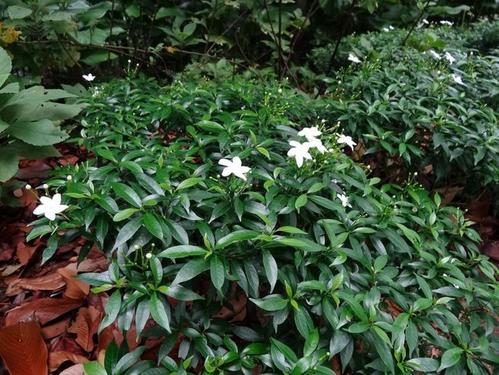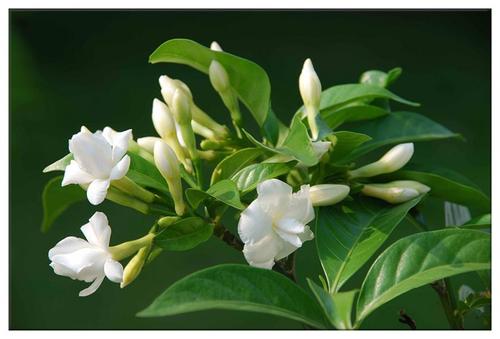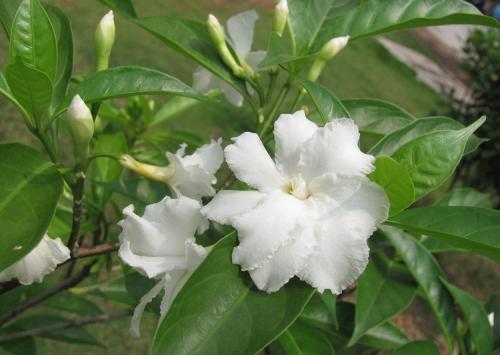Crepe jasmine (Ervatamia divaricata) profile
Written by Maggie
Sep 01 2021

Crepe Jasmine, also known as Ervatamia divaricata, is a shrub of genus Crepe Jasmine (Oleander family), usually up to 3 m tall, glabrous except for ciliate sepals; Branches and branchlets are grayish green, lenticellata, longitudinally striated when dry; Internodes are 1.5-8 cm long. Leaves are papery, elliptic or elliptical oblong, shortly acuminate, basally cuneate, 5.5-11.5 x 1.5-3.5 cm, dark green, abaxially light green.
Crepe Jasmine likes high temperature, humid environment, dense branches and leaves, compact plant type, clean white and plain flowers, elegant and simple, long flowering period, for important background and mix color flowers, suitable for flower hedge, flower path or large pot.
The leaves of crepe jasmine are used in medicine and can reduce blood pressure. Folk people say it can cool and relieve fever, reduce swelling, treat eye disease, sores, breast sores, epilepsy, dog bite and so on. Roots are used to treat headaches and broken bones.
Crepe Jasmine is cultivated in the southern provinces of China.
Crepe jasmine picture

Morphological characteristics of crepe jasmine
Branch
Crepe jasmine is a shrub flower, usually up to 3 m tall, glabrous except for ciliate sepals; Branches and branchlets are grayish green, lenticellata, longitudinally striated when dry;Internodes are 1.5-8 cm long. Axillary pseudostipule is ovoid, base enlarged and connate, ca. 2 mm long.
Leaf
Leaves of Crepe Jasmine are papery, elliptic or elliptical oblong, shortly acuminate, basally cuneate, 5.5 -- 11.5 x 1.5 -- 3.5 cm, dark green, abaxially light green; Lateral veins are12 pairs, flat on leaf surface, slightly convex on abaxial surface; Petiole is 0.5-1 cm long.
Flowers
Crepe jasmine is a cyme axillary, usually twinlike, with 6-10 flowers near branchlet tips integrated pseudo dictate; Total pedicels are 2.5-6 cm long; Pedicels are 0.5-1 cm long; Bracts and bracteoles are ovate-lanceolate, 2 mm long and 1 mm wide; Bud tip long oblate acute; Calyx is glandular at base, sepals oblong, margin ciliate, 3 mm long and 2 mm wide; Corolla is white, tube up to 2 cm long; Stamens bearing below middle of corolla tube; Style is 11 mm long, stigma obovoid.
Fruit
Follicles of Crepe jasmine 2.5-7 cm long, poles divergent or curved; Crepe jasmine has 3-6 seeds, oblong.
The ecological habits of the crepe jasmine
Crepe Jasmine likes high temperatures and humid environments. Cold resistance is low, in case of long-term 5- 6 degrees Celsius low temperature, the plant is seriously damaged by freezing, freezing to death below 0 degrees Celsius. Crepe jasmine likes half shade, full light can also grow well. Crepe jasmine likes fertile, wet and well drained acid soil.
Crepe jasmine likes warm and humid, not cold resistant, suitable for semi-shade, like fertile and well drained acid soil. Since Crepe Jasmine leaves the house in April, it has the habit of growing once every one to two years. When changing the basin so, should join compound fertilizer or bean cake to make base fertilizer, undertake pruning to withered branches, weak branches, and buy next half shade place.
Crepe Jasmine should keep the soil moist at ordinary times and should be watered before it dries out. In summer, it is necessary to spray water around frequently to increase the air humidity of the environment. This flower is good fertilizer, and the flowering period is long, 5-September, every 7-10 days should be applied alternately compound fertilizer and manure water. After entering the room at the end of October, it is generally 5-7 days to water once, the soil is slightly wet, and maintain a good light. The room temperature should be kept above 10℃, otherwise the leaves will turn yellow and fall off, and the branches will be frozen below 0℃.
How to grow and care for crepe jasmine
Water care
At ordinary times to keep the soil moist, not to dry that is appropriate watering, summer often to the surrounding water to increase the air humidity of the environment.
Fertilization care
Crepe Jasmine is a good fertilizer with a long flowering period. From spring to autumn, compound fertilizer and manure water should be applied alternately every 7-10 days. After entering the room at the end of October, water should be irrigated once for 5-7 days, and the soil should be slightly wet, and keep good light.
Temperature care
Room temperature should be maintained above 10℃, otherwise the leaves will be yellow and fall off, below 0℃ branches will be frozen.
Light care
Crepe Jasmine is a positive tree, so it is necessary to maintain good illumination during cultivation, otherwise the leaves will be dark yellow and even fall off.

The propagation method of the crepe jasmine
Crepe jasmine can be propagated by cuttings or by high pressure, mainly by cuttings. South China can breed from spring to autumn, but spring is the best. Cut 12--15 cm long, 1--2 years old shoots as cuttings. There is milk flowing from the wound. Wash the SAP first, and then insert them into the wet sand bed under shade or full light.
Disease control of crepe jasmine
Crepe jasmine is a common pest of thrips and aphids.
In the prevention and control of aphids, various means should be used to stop their harmful activities. The main points are as follows:
One, the eradication of aphids, from the beginning of flowers overwintering period, can receive twice the result with half the effort, such as simply relying on the most serious aphids in spring, autumn, prevention and control effect is not significant.
Second, the newly introduced flower seeds and seedlings should be strictly checked to prevent the invasion of new pests in the field, and the soil and old flower pots should be disinfected to kill the remaining eggs.
Three, combined with pruning, the aphids living or eggs latent over the residual flowers, disease withered leaves, thoroughly removed, concentrated burning.
4. The breed of flowers is different, its fight bug sex also differs somewhat, should choose fight bug breed, reduce aphid harm already but economize medicament charge again.
Five, the discovery of a small amount of aphids, can be dipped in water brush clean, or potted flowers tilt under the tap water rotary rinse, both extinguished the aphids, and wash the leaves, improve the ornamental value and promote leaf surface respiration; The natural enemies such as ladybug and lacewing can also be used for prevention and control if possible.
Six, when a large number of aphids are found, they should be isolated in time and immediately use drugs or indigenous methods to eliminate the pests. The specific measures are as follows:
1, with the ratio of 1:15 preparation of tobacco water, soak for 4 hours after spraying.
2, with a ratio of 1:4:400, preparation of washing powder, urea, water solution spray.
3. Spray with 10% oxidize diethoate emulsion 1000 times liquid or Mala sulfur emulsion 1000 to 1500 times liquid or DDVP emulsion 1000 times liquid.
4. When applying any agent, 1‰ neutral soapy water or washing powder should be added to aphids covered with wax powder.
Species taxonomy of the Crepe Jasmine
Crepe jasmine is also a common cultivated species, including Hainan Crepe jasmine, hairy Crepe jasmine, and hairy Crepe jasmine.
The distribution area of the crepe jasmine
Crepe Jasmine is native to tropical areas of Asia and Oceania and is widely cultivated in South China.
Crepe jasmine is native to the coastal provinces of southern China. It has white flowers with wrinkled edges and single or double petals. Crepe jasmine has a light fragrance and is crystal white. However, Crepe Jasmine is cultivated in most parts of China, concentrated in most areas of East China, Southwest China and Central China. The flowers of Crepe Jasmine have a strong fragrance, and the flowering period is from May to August.
Crepe jasmine value
Medicinal value
Hypertension, sore throat, ulcerative lesions, bruises.
Potted plants use
Crepe Jasmine has dense foliage and compact plant type. The flowers are white and plain, elegant and simple, and the flowering period is long. It is suitable for making hedges, flower paths or large potted plants as an important backdrop and color mixing flowers.
Green leaves, glittering and translucent white flowers and elegant fragrance, is an excellent potted flower.

Latest Updated
- Benefits of Bugleweed - 7 Science-backed Health Benefits
- Bugleweed Dangers & Side Effects - Is It Poisonous?
- How to Plant Evergreen Trees - What You Should Know
- When to Plant Evergreens - Grow Guide for Evergreen Trees
- 12 Wonderful Evergreen Shrubs for Your Garden
- 12 Popular Evergreen Plants with Pictures for Beginners
- When And How To Prune A Lilac Bush Like a Pro
- How to Grow & Care for Lilac Vine (Hardenbergia Violacea)
- Japanese Lilac Tree (Syringa Reticulata) Care & Propagation Guide
- Shumard Oak Pros and Cons - What to Know
Popular Articles
- Winter maintenance of Antirrhinum Majus
- How to Grow Terminalia Mantaly Tree
- How to Grow and Care for Crossostephium Chinense
- How to grow Antirrhinum Majus in spring
- Peristeria Elata (Dove Orchid) Profile: Info & Care Guide
- Underwatered Snake Plant (Sansevieria Trifasciata) - Signs And How To Fix
- How to Care for Brazilian Jasmine Plant (Mandevilla Sanderi)
- How to Grow & Care for Graptopetalum Purple Delight in Summer
- Rosa Chinensis (China Rose): Plant Growing & Care Tips
- How to Care for Baby Sun Rose (Aptenia Cordifolia)